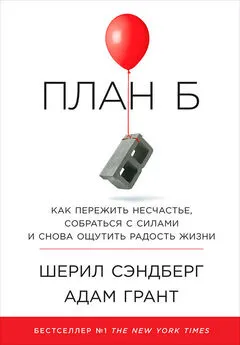Адам Грант - Подумайте еще раз. Сила знания о незнании
- Название:Подумайте еще раз. Сила знания о незнании
- Автор:
- Жанр:
- Издательство:Манн, Иванов и Фербер
- Год:2021
- Город:Москва
- ISBN:9785001698531
- Рейтинг:
- Избранное:Добавить в избранное
-
Отзывы:
-
Ваша оценка:
Адам Грант - Подумайте еще раз. Сила знания о незнании краткое содержание
Для всех, кто хочет научиться критически оценивать реальность и свои решения, переосмысливать и переучиваться, двигаясь вперед.
Подумайте еще раз. Сила знания о незнании - читать онлайн бесплатно ознакомительный отрывок
Интервал:
Закладка:
157
Jesse David Fox, «The History of Tina Fey and Amy Poehler’s Best Friendship», Vulture, December 15, 2015, www.vulture.com/2013/01/history-of-tina-and-amys-best-friendship.html.
158
Michael Gallucci, «The Day John Lennon Met Paul McCartney», Ultimate Classic Rock, July 6, 2015, ultimateclassicrock.com/john-lennon-meets-paul-mccartney.
159
Rosanna Greenstreet, «How We Met: Ben Cohen and Jerry Greenfield», Independent, May 28, 1995, www.independent.co.uk/arts-entertainment/how-we-met-ben-cohen-and-jerry-greenfield-1621559.html.
160
Karen A. Jehn, «A Multimethod Examination of the Benefits and Detriments of Intragroup Conflict», Administrative Science Quarterly 40 (1995): 256–82.
161
Penelope Spheeris et al., The Little Rascals, directed by Penelope Spheeris, Universal Pictures, 1994.
162
William Goldman, The Princess Bride, directed by Rob Reiner, 20th Century Fox, 1987.
163
David Mickey Evans and Robert Gunter, The Sandlot, directed by David Mickey Evans, 20th Century Fox, 1993.
164
Frank R. C. de Wit, Lindred L. Greer, and Karen A. Jehn, «The Paradox of Intragroup Conflict: A Meta-analysis», Journal of Applied Psychology 97 (2012): 360–90.
165
Jiing-Lih Farh, Cynthia Lee, and Crystal I. C. Farh, «Task Conflict and Creativity: A Question of How Much and When», Journal of Applied Psychology 95 (2010): 1173–80.
166
Carsten K. W. De Dreu, «When Too Little or Too Much Hurts: Evidence for a Curvilinear Relationship between Task Conflict and Innovation in Teams», Journal of Management 32 (2006): 83–107.
167
Robert S. Dooley and Gerald E. Fryxell, «Attaining Decision Quality and Commitment from Dissent: The Moderating Effects of Loyalty and Competence in Strategic Decision-Making Teams», Academy of Management Journal 42 (1999): 389–402.
168
Kathleen M. Eisenhardt, Jean L. Kahwajy, and L. J. Bourgeois III, «How Management Teams Can Have a Good Fight», Harvard Business Review, July — August 1997, 77–85.
169
Kathleen McCoy, E. Mark Cummings, and Patrick T. Davies, «Constructive and Destructive Marital Conflict, Emotional Security and Children’s Prosocial Behavior», Journal of Child Psychology and Psychiatry 50 (2009): 270–79.
170
Donald W. Mackinnon, «Personality and the Realization of Creative Potential», American Psychologist 20 (1965): 273–81.
171
Paula Olszewski, Marilynn Kulieke, and Thomas Buescher, «The Influence of the Family Environment on the Development of Talent: A Literature Review», Journal for the Education of the Gifted 11 (1987): 6–28.
172
Robert S. Albert, ed., Genius & Eminence (Oxford: Pergamon Press, 1992).
173
Lauri A. Jensen-Campbell, Jennifer M. Knack, and Haylie L. Gomez, «The Psychology of Nice People», Social and Personality Psychology Compass 4 (2010): 1042–56; Robert R. McCrae and Antonio Terraciano, «National Character and Personality», Current Directions in Psychological Science 15 (2006): 156–61.
174
По результатам анализа более чем 40 миллионов твитов [ Bryor Snefjella, Daniel Schmidtke, and Victor Kuperman, «National Character Stereotypes Mirror Language Use: A Study of Canadian and American Tweets», PLoS ONE 13 (2018): e0206188. ], самые распространенные в постах американцев слова — бранные (sh*t, b*tch, hate и damn), а у канадцев — «спасибо», «отлично», «хорошо» и «конечно».
175
Henk T. van der Molen, Henk G. Schmidt, and Gerard Kruisman, «Personality Characteristics of Engineers», European Journal of Engineering Education 32 (2007): 495–501; Gidi Rubinstein, «The Big Five among Male and Female Students of Different Faculties», Personality and Individual Differences 38 (2005): 1495–503.
176
Stéphane Côté and D. S. Moskowitz, «On the Dynamic Covariation between Interpersonal Behavior and Affect: Prediction from Neuroticism, Extraversion, and Agreeableness», Journal of Personality and Social Psychology 75 (1998): 1032–46.
177
Personal interviews with Brad Bird, November 8, 2018, and April 28, 2020; Nicole Grindle, October 19, 2018, and March 17, 2020; and John Walker, November 21, 2018, and March 24, 2020; «The Creative Power of Misfits», WorkLife with Adam Grant, March 5, 2019; Hayagreeva Rao, Robert Sutton, and Allen P. Webb, «Innovation Lessons from Pixar: An Interview with Oscar-Winning Director Brad Bird», McKinsey Quarterly, April 1, 2008, www.mckinsey.com/business-functions/strategy-and-corporate-finance/our-insights/innovation-lessons-from-pixar-an-interview-with-oscar-winning-director-brad-bird; The Making of «The Incredibles», directed by Rick Butler, Pixar, 2005; Alec Bojalad, «The Incredibles 2: Brad Bird on Family, Blu-Ray Extras, and More», Den of Geek, October 24, 2018, www.denofgeek.com/tv/the-incredibles-2-brad-bird-on-family-blu-ray-extras-and-more.
178
Jeffery A. LePine and Linn Van Dyne, «Voice and Cooperative Behavior as Contrasting Forms of Contextual Performance: Evidence of Differential Relationships with Big Five Personality Characteristics and Cognitive Ability», Journal of Applied Psychology 86 (2001): 326–36.
179
Samuel T. Hunter and Lily Cushenbery, «Is Being a Jerk Necessary for Originality? Examining the Role of Disagreeableness in the Sharing and Utilization of Original Ideas», Journal of Business and Psychology 30 (2015): 621–39.
180
Leslie A. DeChurch and Michelle A. Marks, «Maximizing the Benefits of Task Conflict: The Role of Conflict Management», International Journal of Conflict Management 12 (2001): 4–22.
181
Jing Zhou and Jennifer M. George, «When Job Dissatisfaction Leads to Creativity: Encouraging the Expression of Voice», Academy of Management Journal 44 (2001): 682–96.
182
Amir Goldberg et al., «Fitting In or Standing Out? The Tradeoffs of Structural and Cultural Embeddedness», American Sociological Review 81 (2016): 1190–222.
183
Joeri Hofmans and Timothy A. Judge, «Hiring for Culture Fit Doesn’t Have to Undermine Diversity», Harvard Business Review, September 18, 2019, hbr.org/2019/09/hiring-for-culture-fit-doesnt-have-to-undermine-diversity.
184
Sun Hyun Park, James D. Westphal, and Ithai Stern, «Set Up for a Fall: The Insidious Effects of Flattery and Opinion Conformity toward Corporate Leaders», Administrative Science Quarterly 56 (2011): 257–302.
185
Francesca Gino, «Research: We Drop People Who Give Us Critical Feedback», Harvard Business Review, September 16, 2016, hbr.org/2016/09/research-we-drop-people-who-give-us-critical-feedback.
186
William Safire, «On Language: Murder Board at the Skunk Works», New York Times, October 11, 1987, www.nytimes.com/1987/10/11/magazine/on-language-murder-board-at-the-skunk-works.html.
187
Derek Thompson, «Google X and the Science of Radical Creativity», The Atlantic, November 2017, www.theatlantic.com/magazine/archive/2017/11/x-google-moonshot-factory/540648.
188
Восприятие критики зависит в той же мере от критикующей личности, в какой и от содержания [ David Yeager et al., «Breaking the Cycle of Mistrust: Wise Interventions to Provide Critical Feedback across the Racial Divide», Journal of Experimental Psychology: General 143 (2014): 804–24. ]. В одном эксперименте участники на 40% лучше восприняли критику с комментарием: «Я вам это говорю только потому, что считаю, что вы способны на большее». Принять горькую правду поразительно легко, если говорящий в вас верит и желает вам успеха.
189
The Cambridge Companion to Hemingway, ed. Scott Donaldson (Cambridge: Cambridge University Press, 1996).
190
Elizabeth W. Morrison, «Employee Voice Behavior: Integration and Directions for Future Research», Academy of Management Annals 5 (2011): 373–412; Charlan Jeanne Nemeth, In Defense of Troublemakers: The Power of Dissent in Life and Business (New York: Basic Books, 2018).
191
Jennifer A. Chatman and Sigal G. Barsade, «Personality, Organizational Culture, and Cooperation: Evidence from a Business Simulation», Administrative Science Quarterly 40 (1995): 423–43.
192
De Wit, Greer, and Jehn, «The Paradox of Intragroup Conflict».
193
Ming-Hong Tsai and Corinne Bendersky, «The Pursuit of Information Sharing: Expressing Task Conflicts as Debates vs. Disagreements Increases Perceived Receptivity to Dissenting Opinions in Groups», Organization Science 27 (2016): 141–56.
194
Philip M. Fernbach et al., «Political Extremism Is Supported by an Illusion of Understanding», Psychological Science 24 (2013): 939–46.
195
Leonid Rozenblit and Frank Keil, «The Misunderstood Limits of Folk Science: An Illusion of Explanatory Depth», Cognitive Science 26 (2002): 521–62.
196
Matthew Fisher and Frank Keil, «The Curse of Expertise: When More Knowledge Leads to Miscalibrated Explanatory Insight», Cognitive Science 40 (2016): 1251–69.
197
Dan R. Johnson, Meredith P. Murphy, and Riley M. Messer, «Reflecting on Explanatory Ability: A Mechanism for Detecting Gaps in Causal Knowledge», Journal of Experimental Psychology: General 145 (2016): 573–88.
198
Tim Kreider, We Learn Nothing: Essays (New York: Simon & Schuster, 2012).
199
Personal interview with Harish Natarajan, May 23, 2019; «Live Debate: IBM Project Debater», IntelligenceSquared Debates, YouTube, February 11, 2019, www.youtube.com/watch?v=m3u-1yttrVw.
200
Nicholas Kristof, «Too Small to Fail», New York Times, June 2, 2016, www.nytimes.com/2016/06/02/opinion/building-childrens-brains.html.
201
George Lakoff and Mark Johnson, Metaphors We Live By (Chicago: University of Chicago Press, 1980).
202
Neil Rackham, «The Behavior of Successful Negotiators», in Negotiation: Readings, Exercises, and Cases, ed. Roy Lewicki, Bruce Barry, and David Saunders (New York: McGraw-Hill, 1980/2007).
203
Femke S. Ten Velden, Bianca Beersma, and Carsten K. W. De Dreu, «It Takes One to Tango: The Effects of Dyads’ Epistemic Motivation Composition in Negotiations», Personality and Social Psychology Bulletin 36 (2010): 1454–66.
Читать дальшеИнтервал:
Закладка:










